

Western Fertilizer Handbook 10th Agriculture Edition Available to Consultants November / December 2022 Volume 7: Issue 6 You Can Help Walnut Growers Prevent Sudden Autumn Freeze Damage Nature vs Nutrition: Abiotic stressors are changing the role of the crop consultant















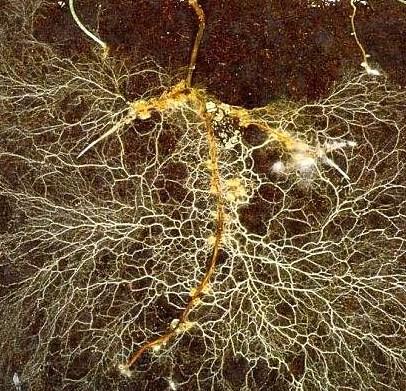
INNOVATION Capturing Maximum Genetic Potential
feed your
il!
IMAGINATION We k now how to
so
Janine Hasey
Jerome Pier Ph.D., CCA, PCA; Editorin-Chief, Western Fertilizer Handbook Third Horticulture Ed. and 10th Agriculture Ed.; Senior Agronomist, QualiTech Agronomy; Past Chair, Western Region Certified Crop Advisors Board of Directors







Alireza Pourrez UC Davis Director, Digital Agriculture Lab; Founder, Kobin Analytics
Kirk Van Leuven
Luke
Clarissa Reyes UCCE Orchard Staff Research Associate, Butte, Glenn and Tehama Counties


IN THIS ISSUE 4 12 CONTRIBUTING
SUPPORT
Dara Director, North Willamette Research and Extension Center
UCCE Pomology Farm Advi sor, Tulare and Kings Counties Elizabeth
UCCE Farm Advisor, Kings and Tulare Counties Steven Koike Tri-Cal Diagnostics
Rijal UCCE Integrated Pest Management Advisor, Stanislaus County
UCCE Area Orchard Systems Advisor, Kern County UC
Jason Scott Email: jason@jcsmarketinginc.com EDITOR: Taylor Chalstrom ASSOCIATE EDITOR: Cecilia Parsons Email: article@jcsmarketinginc.com PRODUCTION: design@jcsmarketinginc.com Phone: 559.352.4456 Fax: 559.472.3113 Web: www.progressivecrop.com You Can Help Walnut Growers Prevent Sudden Autumn Freeze Damage
Fertilizer Handbook 10th Agriculture Edition Available to Consultants
WRITERS & INDUSTRY
Surendra
Kevin Day
Fichtner
Jhalendra
Mohammad Yaghmour
COOPERATIVE EXTENSION ADVISORY BOARD PUBLISHER:
Western
Nutrition:
are
the crop consultant. Advances in Management of Armyworms in Rice How Specialty Crop Farmers Can Benefit from Drones and Remote Sensing
Nature vs
Abiotic stressors
changing the role of
Taylor Chalstrom Editor
Emeritus
UCCE
Joe Connell UCCE Farm Advisor
Luis Espino
Rice Farming Systems Advisor, Butte and Glenn Counties
UCCE
Emerita,
Farm Advisor
Sutter and Yuba Counties
PCA,
CCA, Territory Sales Manager, Stoller USA
Milliron UCCE Farm Advisor, Butte, Glenn and Tehama Counties
You Can Help Walnut Growers Prevent Sudden Autumn Freeze Damage
 By LUKE
By LUKE

In April 2019, crop consultants from the North San Joaquin Valley to the North Sacramento Valley notified UC farm advisors that orchards were not leafing out as expected (Figure 1). Was this a new disease or disorder? It was not. Although most of the industry didn’t recognize the problem until that April, the damage had been done by a sudden autumn freeze in November 2018. An autumn freeze the following year in November 2019 was less severe, affecting far less acreage but still damaging trees in known cold pockets up and down the valley. Finally, in November 2020, a severe freeze once again affected a widespread swath of walnut orchards from the North San Joaquin to the North Sacramento Val ley. Some walnut orchards in the coldest pockets of the Central Valley were hit by all three of these freeze events in addition to an April freeze event in 2022.
Previously thought of as a rare event, sudden autumn freeze damage has oc
curred in three of the last four years, and consultants need to work with growers to make preparing for these freeze events a regular part of summer and fall orchard operations.

How to Reduce Future Damage
For mature trees, don’t apply any addi tional nitrogen (N) from September on wards to prevent tender new growth that is most vulnerable to freeze damage. For young trees, it’s best to cut off N applica tions by mid-August.
For young trees, withhold irrigation starting in early to mid-September, waiting to resume irrigation until after a terminal bud (Figure 2) is set on the trunk. After the terminal bud has set, resume irrigation to avoid tree stress and defoliation, without the fear of pushing tender new growth.
For bearing trees, terminal buds may set as a positive side effect of the water cutoff
done ahead of harvest to avoid shaker injury.
Maintain short groundcover during autumn frost season beginning mid-Oc tober. Keeping groundcovers cut to two inches or less during frost season allows sunlight to reach the soil surface, increas ing soil heat storage for a warmer orchard through the night. Recently cultivated soil has many air spaces, low heat storage capacity and low heat conductivity, re sulting in colder minimum temperatures. The ground surface must be moist for bare ground to be the warmest (see steps four and five.) Be familiar with the infil tration rates of your soils to better plan irrigations for freeze mitigation.
Trees with adequate soil moisture are better able to withstand low tempera tures without damage than trees in dry soil since water-filled spaces in the soil conduct and store more heat than empty airspaces. If there has not been
4 Progressive Crop Consultant November / December 2022
adequate
MILLIRON | UCCE Farm Advisor, Butte, Glenn and Tehama Counties, JANINE HASEY | UCCE Farm Advisor Emerita, Sutter and Yuba Counties, CLARISSA REYES | UCCE Orchard Staff Research Associate, Butte, Glenn and Tehama Counties and JOE CONNELL | UCCE Farm Advisor Emeritus
Figure 1. Very limited leaf-out in April 2019 in a Chandler orchard near Gridley, Calif. (photo by L. Milliron.)
Figure 2. Withhold irrigation until a terminal vegetative bud sets on trunk (photo by J. Hasey.)
rainfall by the end of October, irrigate both young and mature orchards so the soil surface is kept moist going into November. To know if rainfall is meet ing this moisture need or if irrigation is necessary, compare rainfall totals with ET and monitor soil moisture levels by hand or with sensors, with a focus on the top 12 inches of soil. These top 12 inches of soil are the most important for freeze mitigation and should be kept at field ca pacity (not saturated/ponding) if possible. Either a dry surface crust on one extreme or a frozen sheet of ponded water on the other extreme will both hinder the re-ra diation of stored daytime heat during the night.
Continue to actively monitor soil mois ture and freeze predictions in November and December (until trees are acclimated to frost). Since frost is variable depend ing on location, monitoring each block remotely with a frost alarm makes good sense. If a freeze is predicted and the soil is dry, it should ideally be wetted two to three days before a freeze event to fill
the air spaces so the soil will store more heat. Light irrigation to moisten a dry soil surface the morning before a frost will help obtain the greatest heat storage for re-radiation at night (if there is no stand ing water during the freeze event that can lead to evaporative cooling.)
Some growers with the ability to actively irrigate during sudden autumn freeze events have reported great success in pre venting damage. We know from work in almonds that active frost protection with solid set can achieve as much as three to four degrees and microsprinklers can achieve one to two degrees of warming. Running a drip system during a frost may provide very slight benefits due to radi ation from freezing water in the wetted area beneath the trees.
The best approach to escape damage from a fall freeze is to have frost alarms ready and turned on by October 15, completely rehydrate trees after harvest, rehydrate the top foot of soil two to three days ahead of a forecast frost and actively
irrigate during frost events.
When to Stop Monitoring
Fully dormant mature, healthy trees can tolerate temperatures to the low 20s (de grees F) or below. However, walnut trees must first fully acclimate to withstand severe freeze events. We believe walnuts acclimate by having the first frost events in autumn with lows near 32 degrees F or just below. In the widespread freeze damage Novembers of 2018 and 2020, the daily lows were in the 40s and 50s before temperatures rapidly dropped well below freezing (Figure 4, see page 6). As we write this in late October 2022, once again lows are in the 40s and 50s, which is not helping the trees acclimate for freezing conditions.
We do not yet know how many (one, two, three, etc.) freeze events are required to acclimate trees in autumn. If the soil is dry ahead of the third, fourth and maybe additional freeze events, it’s better to irrigate and be safe if you can do so. In
November / December 2022 www.progressivecrop.com 5
ContinuedonPage5 Contact us to see how we can help! (559)584-7695 or visit us as www.superiorsoil.com Serving California since 1983 ContinuedonPage6
addition, consider keeping up your freeze response program longer into fall or early winter for younger orchards with lots of current season’s growth.

As growers were reminded this past April, autumn is not the only time that walnuts can be damaged by a freeze event. Learn more at sacvalleyorchards.com/walnuts/ horticulture-walnuts/preparing-for-ex treme-events-spring-frost.
Damage Suspected
If you suspect freeze damage occurred, cut into the branches shortly after the freeze event and check the tissue for dry ing or browning (Figure 3a and 3b). Swift action in the week after a freeze event can significantly decrease damage. Sunburn after freeze can further damage tissue on the southwest side of the tree. Paint the southwest side of damaged trees with 50% diluted (1:1 water to paint) white interior latex paint. Painting up to a week after the freeze event can reduce addi tional damage by half or more.
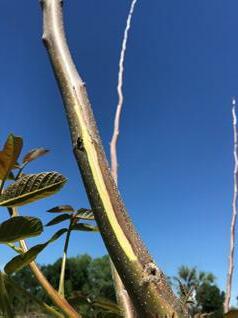

If you notice that walnut trees you consult on are not leafing out properly in spring, the first thing to do is look back at temperature records and see if there was a sudden autumn freeze event (Figure 4). The second thing you should advise your grower to do is wait. Don’t start cutting out dead wood until June; wait to see what eventually emerges from late leafout or from epicormic shoots that arise from dormant buds along the branches (the tree’s emergency response to regrow the canopy following severe damage.) With the help of these epicormic shoots, the Gridley orchard pictured at the start of this article had massive regrowth by the end of the year (Figure 5). Also, wait on irrigation since healthy walnut or chards typically don’t need to be irrigated until May even in drought years (waiting for two to three bars drier than the fully watered baseline with the pressure cham ber (sacvalleyorchards.com/walnuts/irri gation-walnuts/spring-start)).
With the severe reduction and delay in leaf-out, there is even less water use early in the season, and irrigating early (e.g., April) could actually damage root health by providing water the tree doesn’t need yet. Re-assess your nutrition program for

the block, reducing those inputs with the reduced crop size expected. Finally, con sider applying the 50:50 dilute white latex paint to the southwest side of the tree to prevent further sunburn. You can learn more about freeze recovery, including the increased risk of Botryosphaeria and Phomopsis (BOT) infection at sacvalley orchards.com/walnuts/horticulture-wal nuts/2020-freeze-recovery.
The authors would like to sincerely thank an amazing team of UC researchers who have worked on freeze prevention over the years. This work is made possible by the generous funding support of the California Walnut Board.
Comments about this article? We want to hear from you. Feel free to email us at article@jcsmarketinginc.com
6 Progressive Crop Consultant November / December 2022
ContinuedfromPage5
Verona (Sutter Co.) CIMIS
data, Oct 15--Nov 30 Date Minimum air temp, F 50 40 30 10-26 10-20 11-04 11-19 10-31 11-10 11-25 11-15 11-30 2019 2020 2018
Figure 4. Minimum air temperatures at the Verona (Sutter County) from October 15 to November 30 in 2018, 2019 and 2020. Lows in the 40s and 50s (degrees F, light red boxes) precede the freeze event(s) (red arrow descending below the light blue 32 degrees F freezing line.)
Figure 3a. 3b. This characteristic distinct margin of dead and living tissue is typically seen in young orchard blocks. Shown both before (left) and after cutting (right) (photos by L. Milliron.)
Figure 5. Freeze damaged Chandlers in Gridley, same trees over time. In the April panel, these trees had very few leaves when they should have leafed out by mid- to late-April. Come May, leaves emerged from bare branches at the top of the canopy. By October, the canopy showed significant growth but still had some bare wood (photos by L. Milliron.)
OPTIMIZE
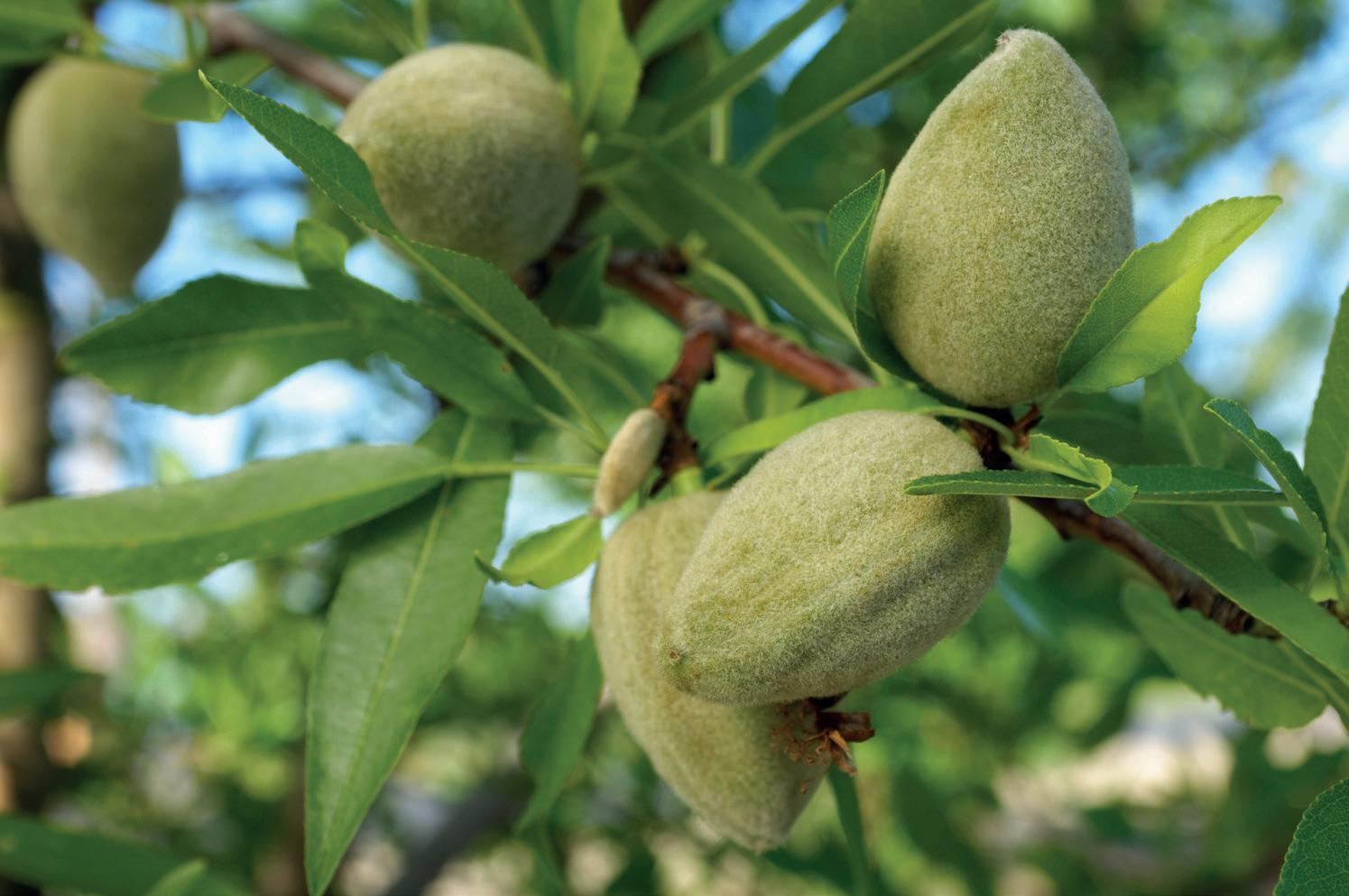



YOUR
Tessenderlo Kerley, Inc. All rights reserved. CaTs® is a registered trademark of Tessenderlo Kerley, Inc. Call: (800) 525-2803 | Email:
soluble calcium conditions soil, thereby
water
Blends with most nitrogen fertilizers, including UAN and liquid urea. Easy and convenient application any time of season.
water use efficiency.
WATER EFFICIENCY ©2022
info@cropvitality.com www.cropvitality.com 100%
improving
infiltration.
Improves
Western Fertilizer Handbook 10th Agriculture Edition Available to Consultants
 By JEROME PIER | Ph.D., CCA,
By JEROME PIER | Ph.D., CCA,
PCA; Editor-in-Chief, Western Fertilizer Handbook Third Horticulture Ed. and 10th Agriculture Ed.; Senior Agronomist, QualiTech Agronomy; Past Chair, Western Region Certified

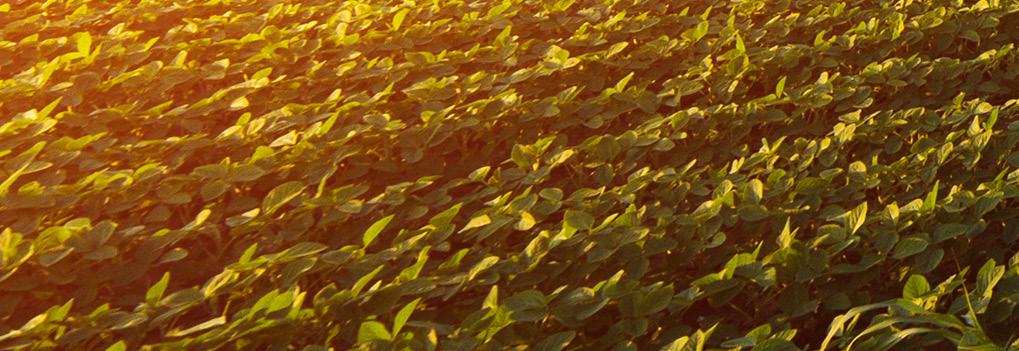
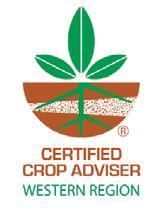
Crop Advisors Board of Directors
The Western Plant Health Association is pleased to announce the publication of the Western Fertilizer Hand book 10th Agriculture Edition, available from Waveland Press, Inc. The Handbook has been providing quick access to agronomic information for crop advisors since the first edition was published in 1953. The Handbook provides fundamental information on plant growth and essential nutrients, soil and
The Western Fertilizer Handbook has been providing quick access to agronomic information for crop advisors since the first edition was published in 1953. The new 10th edition is available now.
water science, soil and plant analysis, both conventional and organic fertilizer sources, fertilizer formulation, storage and application, and nutrient management. Candidates eligible to become Certified Crop Advisors in the Western Region (Cali fornia and Arizona) use the Handbook as a study guide for the regional exam. I like to say the Handbook is the “First Re sponder Manual” for crop advisors. The internet has become a treasure trove of information for the busy professional, but the Western Fertilizer Handbook is always ready with quick answers, especially when the cellphone connection says, “No Service.”
The Soil Improvement Committee, under the auspices of the Western Plant Health Association, is a collection of field agronomists and scientists from California and other West ern states who have provided and reviewed the content of the Handbook from the First Edition. The Committee meets on a regular basis to discuss trends in Western agriculture. New editions of the Handbook have been produced by the Com mittee roughly every 5 to 10 years until the Ninth Edition was published in 2002.
In addition to the Agriculture Edition, there is a Horticul ture edition of the Handbook. The Committee decided it was
8 Progressive Crop Consultant November / December 2022
in many

remained the same (photo by Michelle Leinfelder-Miles, UCCE.)


necessary to produce a Third Horticul ture Edition of the Handbook prior to beginning work on the 10th Edition of the Agriculture Edition. A review of the Second Horticulture Edition revealed there were too many similarities be tween the Horticulture and Agriculture editions. The Third Horticulture Edi tion was re-written to be geared toward the turf and ornamental marketplace professional to distinguish it from the Agriculture Edition. I volunteered to be the Editor-in-Chief for the Third Horticulture Edition along with my CoChair, Dave Barlow. The Third Horti culture Edition was finally published in 2012.
I assumed it would be a simple matter to transfer the improvements from the Third Horticulture Edition to a 10th Ag riculture Edition. It didn’t happen that way! During the 10 years between the Third Horticulture Edition and the 10th Agriculture Edition, the Soil Improve ment Committee made slow progress. I was approached by many professionals and agricultural college professors won dering when the new edition would be available. The rise of video conferencing during the pandemic turned out to be a useful means of scheduling the weekly meetings needed to push the Handbook to the finish line. I can say the many substantial improvements found in the 10th Edition made it worth the wait.



Key Changes

The changes in the 10th Edition will be
immediately obvious to everyone who has a well-worn copy of the Ninth Ag Edition in their office or pickup truck. The chapter order has been changed to begin with basic plant growth and development followed by a chapter on plant essential nutrients. Even though there are now thousands of digital photos on the internet of plant nutri ent deficiency symptoms, the Com mittee decided to keep the color plate examples for the 10th Edition. Basic soil and water science chapters follow
the plant growth chapters. The next three chapters provide critical informa tion on conventional fertilizer sources, soil amendments and a new chapter dedicated to organic fertilizers written by Rob Mikkelsen. The fertilizer chapter now includes detailed information on slow- and controlled-release fertilizer materials. The content in the chapter on Formulation, Storage and Handling has been revised to remove descriptions
November / December 2022 www.progressivecrop.com 9
ContinuedonPage10 WESTBRIDGE IS NOW GROWING AS SAN AGROW. Call
or
SOLUTIONS FOR SUSTAINABLE CROP HEALTH AND NUTRITION SAN Agrow offers effective plant nutrients, biopesticides and specialty inputs designed to maximize crop quality and increase yield. ® ® ORGANIC Blossom Protect ™ ® ® ORGANIC Botector ® G ARGOIL® ®
in organic production,
producing specialty crops,
(760) 599-8855
visit www.san-agrow.com.
Increases
regulatory pressure and oversight on fertilizer man agement required a substantial update to the Handbook. However, the fundamentals of
ways, has
of the manufacturing process of ammonium polyphosphates and limited information on dry fertilizer blending, which has been replaced with information on how to produce liquid and dry fertilizer blends. The Application chapter incorporates site-specific fertilizer management, which was a separate chapter in the Ninth Edition. The massive tissue analysis guidelines table from the Soil and Tissue Analysis chapter has been moved to Appendix C. The final chapter was completely re-written to better reflect the more regulatory environment of today. The new chapter is titled Nutrient Management and includes sections on the 4Rs of Nutrient Stewardship, Best Management Practices, environmental protection and exam ples of how to complete a Nitrogen Management Plan. The Appendix covering Model Law Relating to Fertilizer Materials has been removed. Four new tables have been added to the Useful Tables and Conversions appendix. There is still a glos sary of terms explaining words italicized in the text. Even the index was updated and improved.
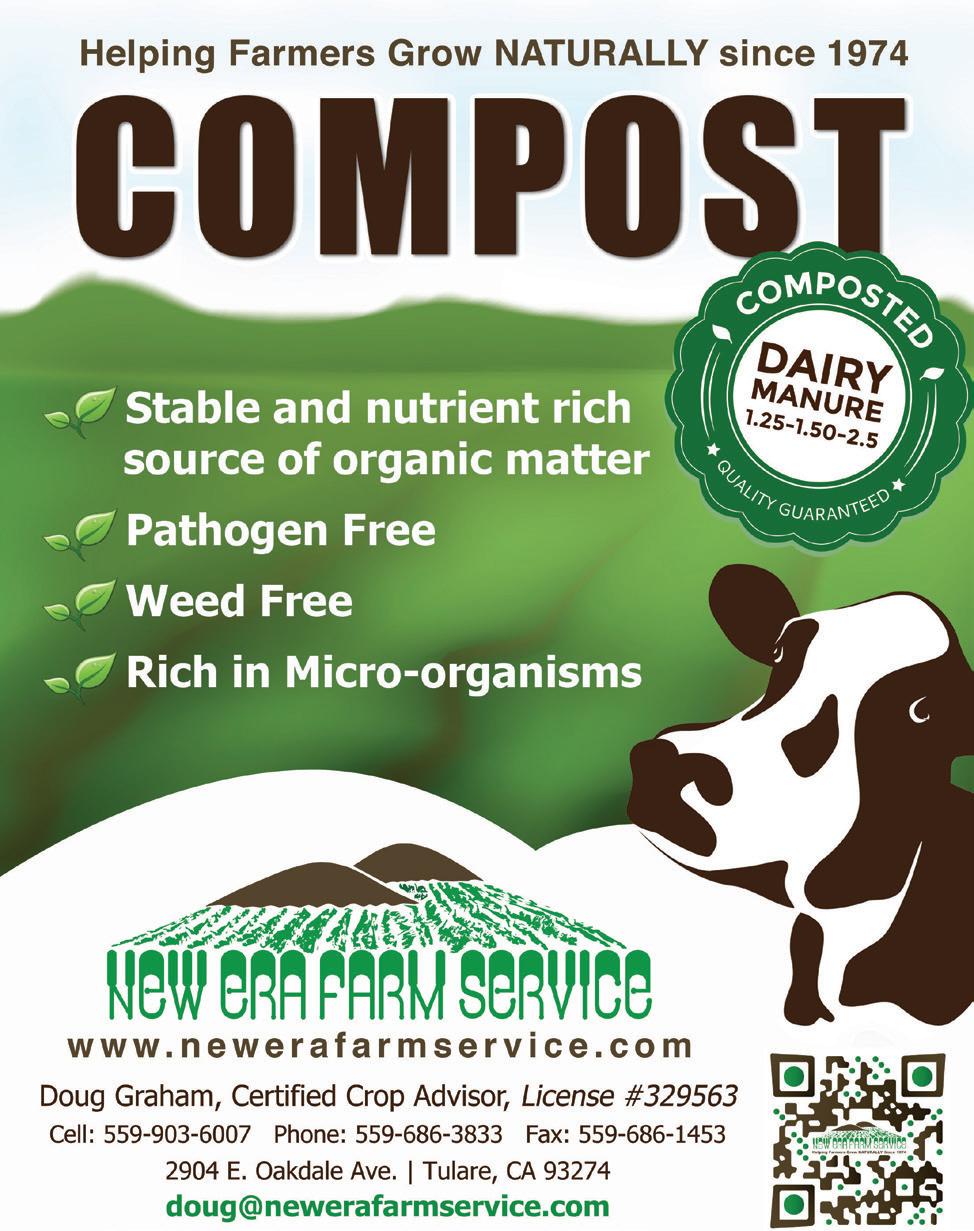



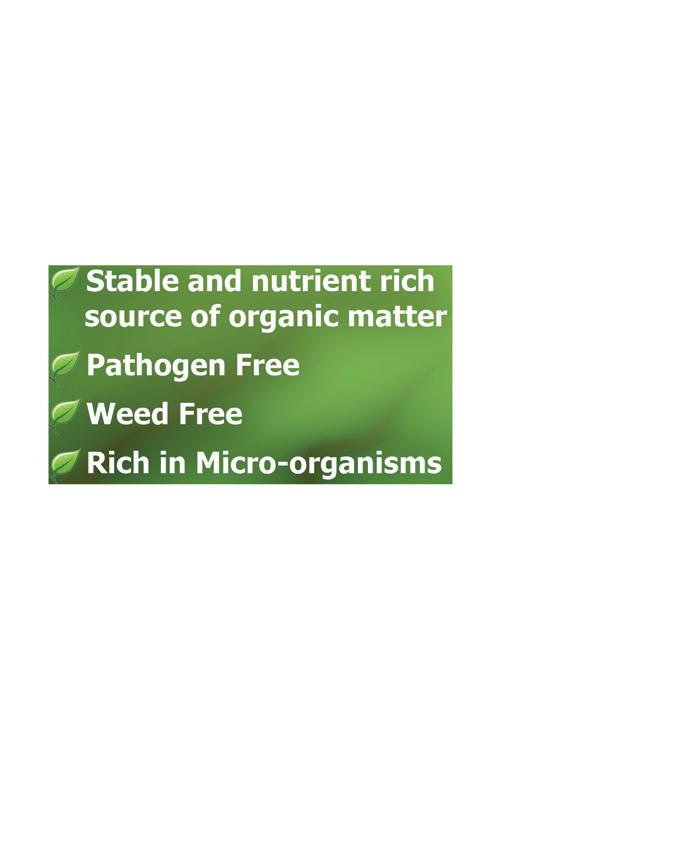
Still the Same Helpful Handbook
With all the updates, those familiar with the Ninth Edition will be comforted to know that all the important information they have come to rely on is still there. Somehow, Waveland Press managed to squeeze 15 more pages of useful informa tion into a slightly thinner book. Although there are those

who will read the Handbook from the beginning to the end, most advisors approach the book from the table of contents,
Handbook lies in the many tables and figures of useful infor
ContinuedfromPage9
O ce: 559-686-3833 Fax: 5 59-686-1453 2904 E. Oakdale Ave. | Tulare, CA 93274 newerafarmservice .com Helping Farmers Grow NATURALLY Since 1974
Jerome Pier spoke with Editor Taylor Chalstrom for MyAgLife in Septem ber on the handbook’s release and overall significance. Listen to the full interview in Episode 431 of the MyAgLife Daily News Report at myaglife.
mation that provide immediate answers to problems encountered in the field.







The 10th Edition is dedicated to Mike Buttress. Mike was part of the editorial team for the Ninth Edition and attend ed every meeting for the 10th Edition. At one of the last editing meetings, he handed me a tattered photocopy of the Ninth Edition Appendices covered in red ink highlighting changes and corrections he wanted to see included in the new edition. As agronomist for A&L Western Labs in Modesto from 1992 to 2015, Mike reviewed and made recom mendations on many thousands of soil and tissue samples. I remember during my early days as an agronomist hear ing Mike give his advice and feedback at technical meetings and thinking I wanted to have that kind of knowledge someday.
The cover of the 10th Edition, a pan orama of sunflowers, is quite striking. I told Don Russo of Waveland Press that I wanted to feature sunflowers on the cover because, well, they are beautiful, and I also wanted to acknowledge the connection farmers have with each oth er around the world, especially Ukraine. Don sent me a mockup he put together and it took my breath away. Choosing photos was one of the hardest tasks in completing the 10th Edition, but choos ing the cover was easy!
The 10th Agriculture Edition of the Western Fertilizer Handbook is a snapshot in time of the state of Western agriculture. Increases in organic pro duction, regulatory pressure and over sight on fertilizer management required a substantial update to the Handbook. However, the fundamentals of produc ing specialty crops, in many ways, has remained the same. I am proud to be part of a long history of agronomists who have contributed their knowledge and expertise to producing the 10th Agriculture Edition.
Comments about this article? We want to hear from you. Feel free to email us at article@jcsmarketinginc.com
November / December 2022 www.progressivecrop.com 11
Zinc-Shotgun® is a fertilizer that focuses on micronutrients to satisfy needs of customers seeking high zinc with manganese, iron and copper. The micronutrients are completely chelated with natural organic acids, amino acids, and carbohydrates that are readily bio-degradable and supply energy to the plant and soil microflora. Many soils are low in zinc and also require other micronutrients for the growth of good crops. We Are Here to Help Call: 209.720.8040 Visit: WRTAG.COM Mn Fe Zn Cu Complete, organically complexed micronutrient package containing essential elements to improve plant health and growth. Organically complexed with plant based amino acids, organic acids, and complexed polysaccharides. The nutrients are readily absorbed by the plant for a faster response. Designed to be applied both by foliar application and fertigation practices and is also e ective when applied directly to the soil.
Nature vs Nutrition Abiotic stressors are changing the role of the crop consultant.
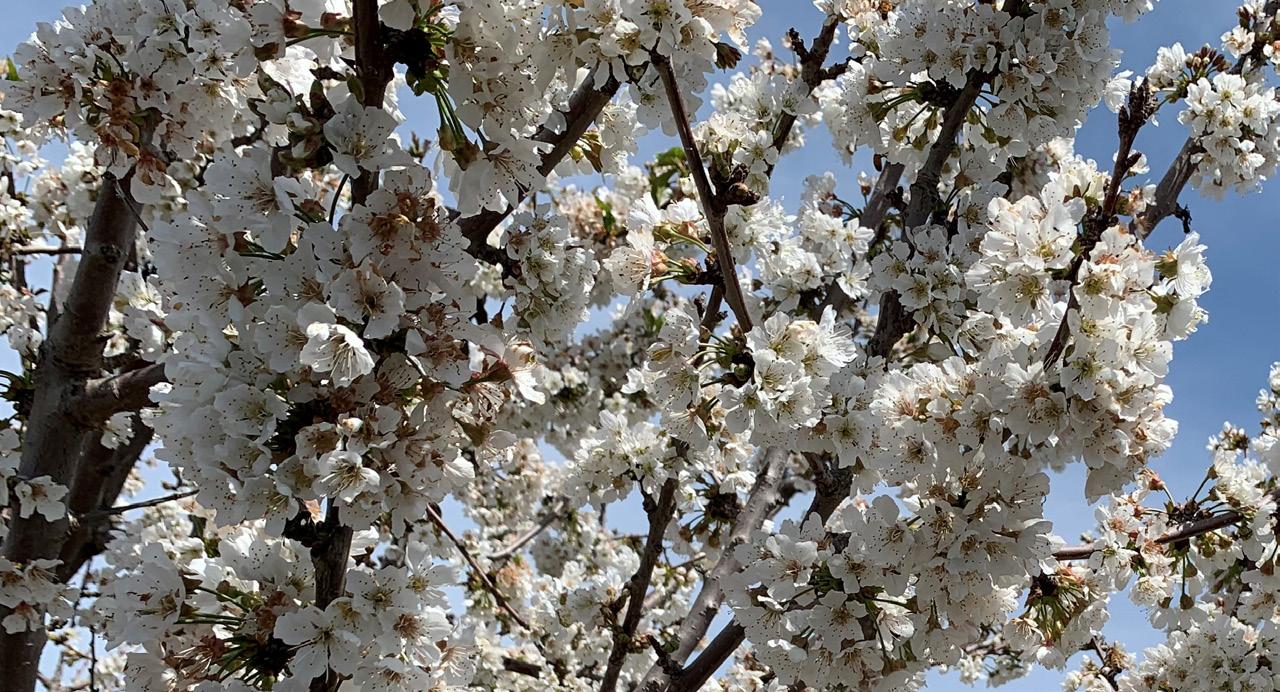


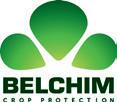 By KIRK VAN LEUVEN | PCA, CCA, Territory Sales Manager, Stoller USA
By KIRK VAN LEUVEN | PCA, CCA, Territory Sales Manager, Stoller USA

SPONSORS
The role of the crop consultant is changing with regular and severe impacts of climate and water issues. Pest and disease problems can even be overshadowed by abiotic stress. This new complexity in the crop consultant’s job calls for upgraded tools and under standing. As a technology supplier, I’m hearing from PCA organizations that they need more training in agronomy and plant physiology to deal with what happens to plants under stress.
At Stoller, I’ve associated for 15 years now with an international network of over 400 agronomists, 20 Ph.Ds. and over 300 research professionals from about 70 countries where we do busi ness. Our knowledge of the components of yield and crop physiology grows with each crop cycle in every country. The founder of the company, Jerry Stoller, spent a lot of time traveling and listen ing to growers’ needs. Growers shared that they generally know what to do about weeds, pests and diseases, but that often the greater impact on the crop is climate and weather events. Stoller went to work developing a toolset to lessen this impact of abiotic stress on yield and quality. The technology focuses on understanding each physiological stage
12 Progressive Crop Consultant November / December 2022
YOU
Heritage Crop Science, LLC ® The Power of Peptides Save the date for the 2023 Crop Consultant Conference: Sept 27-28, 2023. Stay up to date by visiting www.progressivecrop.com/conference
A snowball bloom means extreme expenditure of tree reserves, just one example of abiotic stress (all photos by K. Van Leuven.)
THANK
of development and how stress might impact the crop at each point in its lifecycle.








The concepts of genetic expression and components of yield were developed for commodity crops like grains and soy beans, but yield for any crop depends on how that crop fares through each stage of its lifecycle. Stress or imbalance at any stage will irreversibly reduce genetic expression and crop performance.


























A lot of this can be anticipated based on history and conditions for a particular crop and field location, and season-long programs can be developed. For the rest of this article, the focus will be on deciduous tree crops like fruits and nuts, but the concept of season-long programs for stress management can be applied as well to crops of all kinds.




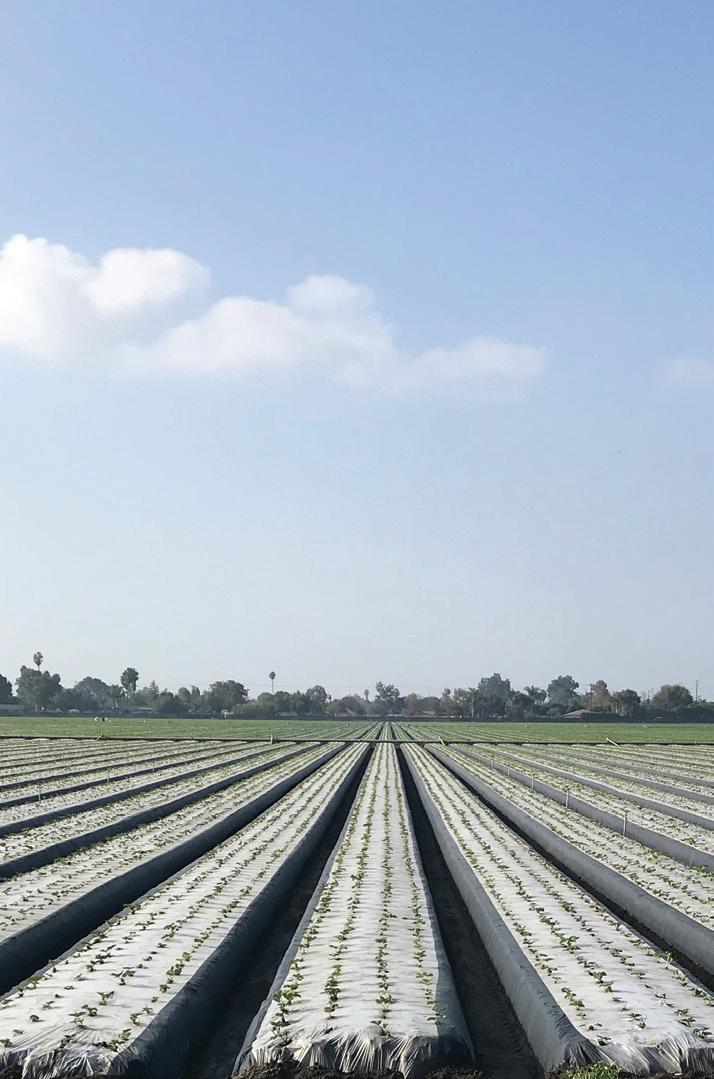
Manage Stress by Growth Stage
Plants physiologically shift gears through different growth stages. I learned to drive on an old farm truck with a manual four-speed and twospeed axle shifter. Clutching and shifting took a little practice, especially when your legs didn’t quite reach the pedals. If you ended up grinding it or not getting into gear, you lost speed and would sometimes even have to go back down a gear. In a worst-case scenario, you might even have to stop and start over. The same concept applies to the physiological stages of crops. The genetic code of the plant wants to keep advancing through the life cycle, but stress or imbalances can slow or stall the development and effect flowering, fruit set, plant growth, fruit size, color or quality.
There are only two ways that a plant can grow: cell division and cell enlargement. Since cell division only takes place in the meristematic tissue, the main points of growth are the root tips and the api cal growth points of the shoots. These two meristematic zones have potential for a longer period of cell division when environmental and nutritional condi tions are met. New growth points can develop also in the buds. But when these develop into flowers and set fruit with their new embryos, the time for cellular
division is relatively short before the shift is made to cell enlargement. Plan ning to optimize nutritional resources and managing stress through this crit ical cell division stage is an important feature of a good season-long program.
Deciduous fruit and nut trees start out with more than one source of stress in the spring. When we think of a typical bloom period for almonds or cherries for example, weather can be unpredict able. Soils are still below 60 degrees
F and might be wet or dry. Nutrient uptake is limited. Without leaves and photosynthesis, the flowering and early growth of the fruit depends solely on nutritional and hormonal reserves from the prior season. Additionally, whether by design or by short supply, watering may not be started up yet. If water was limited also by CDI or lack of water at the end of the prior growing season, or over a dry winter, flowering and fruit set
November / December 2022 www.progressivecrop.com 13
Other Innovative Products* From Belchim Crop Protection: Visit:www.belchimusa.com Belchim Crop Protection USA, LLC 2751 Centerville Road | Suite 100 Wilmington, DE 19808 Phone: 855-445-7990 Email: info.usa@belchim.com • PROVIDES Uniform Penetration and Lateral Movement of Water • ENCOURAGES Improved Rooting and Nutrient Uptake • IMPROVES Distribution and E ectiveness of Soil Applied Chemicals • SAVES WATER - Reduces Irrigation Requirements by Up To 25% Other Innovative Products From Belchim Crop Protection: Visit:www.belchimusa.com Do More With Less Water! Integrate® 80+ ENHANCES WATER MOVEMENT and Gets MORE Applied Water To The Rootzone, and LESS To Run O and Evaporation. ContinuedonPage14
and early season growth can be severely affected. The flower ing process itself is exhaustive of tree energy and nutritional reserves. If all of this sounds like a deprivation, it shouldn’t surprise anyone that only a small percentage of flowers set fruit, and then when competition within the tree causes a hunger, a drop will occur.

Stay Ahead of the Game
Economically, a season-long program of stress management and nutrition is not expensive when compared to the potential losses from inadequate water or nutrition, or from stress of any kind. Growers and consultants who understand crop nu trition and physiology with the key timings for components of yield will see positive returns on their investment to preserve and finish the crop.
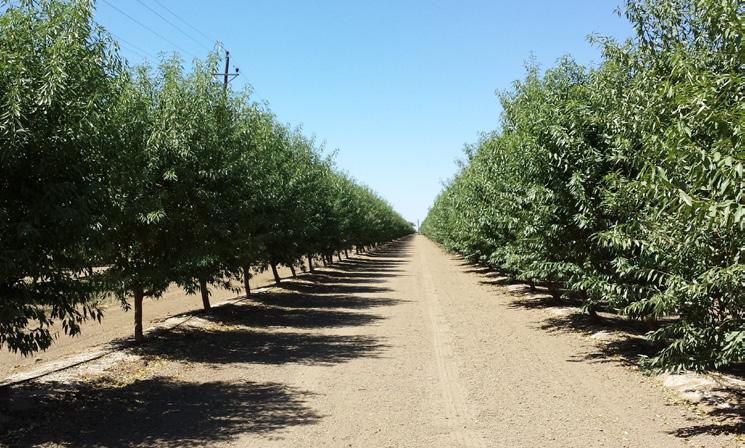

Transplant shock is one of the most obvious forms of stress. Getting a new plant past the establishment stage to be actively growing in both the roots and the apical shoots is job one. Permanent crops planted from nursery stock are no different than a small vegetable transplant in this regard. Growing conditions are not always ideal at the time of planting. Having berms or beds and irrigation prepped and providing appro priate nutrition and stress management from the start is the fastest way to get your planting to early production. The best plant architecture requires appropriate vigor and fast estab lishment. For most varieties, medium vigor is better than too much. Vigorous scion/root combinations can have a problem settling into early production and high yields.
The two main delivery systems for fertilizer inputs on perma nent crops are foliars and fertigation. When selecting the right fertilizer for the crop, having the choice of delivery systems for a particular timing is important. Foliar nutrients can be tank mixed when the timing lines up with other sprays. Some consultants are now timing pesticidal applications according to crop physiological timings rather than piggy-backing nu trient sprays on pest control. A good argument can be made for either case, but when crop phenology and pest and disease timings line up, there is nothing more efficient than tank-mix ing the nutrients required by the plant for that timing. There are a lot of good foliar materials on the market, and even selected generic fertilizers can be appropriately used.
14 Progressive Crop Consultant November / December 2022
ContinuedfromPage13 ContinuedonPage18
Salt bands on almond berms (left) from irrigation at 80% evapotranspiration (ET). The same almond orchard (right) with salt rings watered at 80% ET shows lush growth and no stress because available calcium was applied by fertigation.




November / December 2022 www.progressivecrop.com 15 Get Ahead of Powdery Mildew for Next Seasons Grapes BECAUSE THE DISEASE HITS QUICKLY, YOU NEED TO HAVE A PRODUCT IN PLACE BEFORE THE DISEASE OCCURS. Lime-Sulfur Solu�on’s small par�cle size • Disperses more evenly • S�cks more tenaciously Giving you residual control and extended protec�on. MICRONIZED SULFUR VS LIME-SULFUR SOLUTION Learn more about Lime-Sulfur Solu�on at www.novasource.com Always read and follow label instruc�ons. NovaSource® and Lime-Sulfur Solu�on™ are registered trademarks of Tessenderlo Kerley, Inc. | ©2022 Tessenderlo Kerley, Inc. All rights reserved.
Crop Vitality’s Research Farm Provides Growers with Real-World Results
IN THE AGRICULTURAL WORLD, A DEMONSTRATION ALWAYS BEATS AN EXPLANATION.
That’s why Crop Vitality has 107 acres of farmland in Dinuba, California: to prove the value of its Tessenderlo Kerley sulfur-based fertilizer products on crops in some of America’s most productive farmland.
“There are so many crop nutrition offerings out there, and a lot of them are not backed up with science. We wanted a place where we can test our existing products, while also testing new offerings that our agronomy team develops. This is a way for us to get data in real-world conditions and help with the growing challenges faced by farmers each year,” said Ray Maestas, manager of the Crop Vitality Research Farm in Dinuba.
Simply known as “the farm” by Crop Vitality employees, the farm was purchased in 2016 with research and educational opportunities being its core purpose. The research helps Crop Vitality’s agronomy team yield clues to potential new practices that may diversify agriculture.

The farm has the ability to grow a wide variety of crops. That includes broad-acre crops such as corn, soybeans, and specialty crops like almonds, pistachios, fruits and vegetables. The farm also has multiple greenhouses and labs for additional studies which use different soils to help determine the best nutrient management program.
At the farm, Crop Vitality tests products from their Tessenderlo Kerley line of liquid fertilizers, such as Thio-Sul®, KTS®, K-Row 23®, CaTs® and N-Sure®. The goal, Maestas said, is to provide an invaluable resource for
16 Progressive Crop Consultant November / December 2022
Advertorial
customers, growers and researchers. If it’s impacting their yields, whether it be due to a nutrient deficit or water efficiency, the research conducted at the farm helps the community by studying the grower’s problem.

“It’s also a way for us to follow the development of products from the lab to the field,” Maestas said. “Our agronomist will have an idea and develop it in the laboratories, test it the greenhouses, and then on our fields, giving them the confidence that we can turn it into largescale trials in our growers’ fields.”
They don’t limit themselves to the 260-plus Californiabased crops, with multiple soil types the farm grows and researches crops from all over the USA.
grown throughout the farm. They even enjoyed sampling some almonds, grapes, and other crops straight from the source.
“These events are a way for us to bring our customers’ PCAs and CCAs, as well as independent crop consultants and growers to the farm – and be able to not just introduce them to our product lines, but to explore ways to use them better,” Maestas said. “If our customer comes to us and says, ‘We want to test a product out on wheat,’ we have the ability to do that test here in Dinuba – and if it passes the test in 110-degree heat, you know it’s going to be safe on the growers’ fields.”
Maestas said the farm has given Crop Vitality the ability to connect with customers in a way that few companies can, while equipping them with everything they need to meet their growers’ needs – regardless of the crop, and regardless of the season.
“It is important for us to connect with them. Looking at data is easy, but when it is demonstrable and you can see side-by-side crop stature, that visual will stick with you for a long time. Believing, and trusting in Tessenderlo Kerley’s fertilizers gives advisors confidence in recommending our products to a grower,” Maestas said.
“We
to have the best crops available to test our products on,” Maestas said.
The investment in the research farm demonstrates Crop Vitality’s dedication to providing sustainable solutions to nurture crop life under real-world conditions. When you are on the farm you are family, they take pride in the stewardship and the solutions that they bring to the ag community.
In May, Crop Vitality brought a new element to the farm and opened a 2,400-square-foot meeting facility and event area. It was designed for additional educational opportunities – a place to host local grower groups in roundtables, hold continuing education classes for ag professionals and put on customer appreciation events. The flexible meeting space in the facility holds up to 120 participants.
Early this fall, Crop Vitality’s agronomists utilized the new meeting facility with customers and growers from around the country. They reviewed important crop nutrition data, and the agronomy team took them on a tour of the crops
Contact us today: Email info@cropvitality.com | Visit CropVitality.com
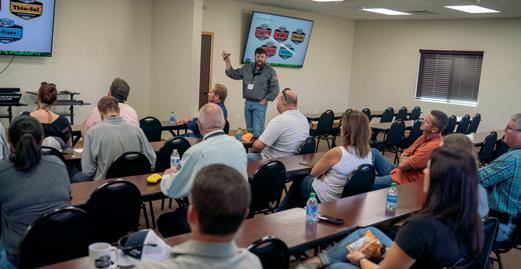
November / December 2022 www.progressivecrop.com 17
want
“We do our best to put out the most robust trials that we can. That way, when we hang our hat on our data, we can show that it was done in the most stringent manner.”
© 2022 Tessenderlo Kerley, Inc. Crop Vitality® is a registered trademark of Tessenderlo Kerley, Inc.
Protect the Roots
Some of the best foliar fertilizers have systemic activity, meaning within a short time, sometimes within hours, positive effects are visible in the plant. Examples of systemic activity is fruit that gains brix within 24 hours of an application, or the phosphite and phos phate foliars, which have observable effects in the root system after foliar


applications. Root stimulation is one of the best ways fight plant stress. But when water deficits occur or root sys tems are compromised by water quality or mounting problems with soil chem istry, the root hairs die off, rendering an imbalance in the plant.
A famous quote by Jerry Stoller is that the “roots are the brains of the plant.”
In particular, it is the root tips that are the brains. The root caps respond in the soil environment with biofeedback to the plant whether the requirements for growth are present. The key nutrient re quired for cell division and root growth is calcium. Root tips stop growing with in hours when available calcium runs out in the soil solution, and in 7 to 14 days without replenishing this import

18 Progressive Crop Consultant November / December 2022
A late-season cherry orchard showing stress had an excellent crop the following year with a season-long program.
ContinuedfromPage14
Salt-stressed blueberry shows all stages of fruiting at same time.
ant ion, the root cap will die off. Calci um is required throughout the plant for cell division, so especially through the first half of the growing season this ion should be supplied in the rootzone. Not all calcium sources are equally available to the plant.
Calcium’s unique stress-fighting abili ties in the plant result from two or three important ways that the plant uses it on a cellular level. As a structural building block of the cell wall, it is important for resistance to stress. It is also found in important levels in the cellular organ elles and in the cytoplasm. Movements of the calcium ion inside the cell creates signaling for important plant process es. As a messenger, calcium has been compared to the plant hormones. In the rootzone, the calcium ion is recognized and actually preferred by the plant, and calcium uptake is prioritized above oth er ions including sodium. This blocks potential harm to the plant tissues. Providing available calcium in the soil solution can be a first line of defense against plant stress.
Stacking some of these fertilizing concepts together with specific timings for a season-long program is an effec tive way to improve crop performance

and help with yield preservation under abiotic stress. When it comes to crop development, the timing and availability of nutrients is key. What may at first look like an intense nutritional man agement system is not that difficult to implement because of the ability to use either foliars or fertigation in different timings. Growers and consultants who


are making these changes are finding that results with a season-long program is more consistent and the return-on-in vestment to learn it is significant.

Comments about this article? We want to hear from you. Feel free to email us at article@jcsmarketinginc.com
th



T h i s y e a r ’ s a g e n d a w i l l b e p a c k e d w i t h c o n t e n t f o c u s e d o n h e l p i n g g r o w e r s i m p r o v e R O I , i n c l u d i n g b u t n o t l i m i t e d t o :
t i o n
W e d n e s d a y : I r r i g a t i o n F e r t i g a t i o n
T h u r s d a y : R o o t s t o c k s P e s t M a n a g e m e n t
M a k e p l a n s n o w t o j o i n y o u r f e l l o w a l m o n d i n d u s t r y m e m b e r s a t T h e A l m o n d C o n f e r e n c e o n D e c e m b e r 6 8 a t t h e S A F E C r e d i t U n i o n C o n v e n t i o n C e n t e r i n d o w n t o w n S a c r a m e n t o R e g i s t e r n o w a t A l m o n d s . c o m / C o n f e r e n c e

T u e s d a y : W a t e r S u p p l y P o l l i n a
The Almond Conference has been held every year since 1973, making this the 50 consecutive year. The event now attracts more than 250 exhibitors and covers the latest advancements in growing, producing and supplying high quality, great tasting, and healthy almonds!
‘What may at first look like an intense nutritional management system is not that difficult to implement because of the ability to use either foliars or fertigation in different timings.’
Advances in Management of Armyworms in Rice
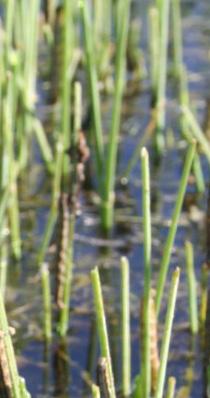



 By LUIS ESPINO | UCCE Rice Farming Systems Advisor, Butte and Glenn Counties
By LUIS ESPINO | UCCE Rice Farming Systems Advisor, Butte and Glenn Counties
Armyworms have always been present in rice, feeding on the foliage and panicles and causing defoliation and blanked panicles branch es (Figure 1). Most of the time, control was not necessary because injury would not typically result in a yield reduc tion. Then, in 2015, a large armyworm outbreak took growers and PCAs by sur prise. I remember the first call I received to inspect a field in Glenn County in late July; the PCA mentioned that they had already sprayed lambda cyhalothrin and that it did not seem that the application did any good. I thought I was going to visit a field with just a few surviving worms and some defoliation. When I got to the field, I was shocked by the number of armyworms and the amount of defo liation they had caused (Figure 2, see page 21). Plants that should have been knee-high were completely defoliated, and only a small piece of stem remained above the water, to which the army worms hung on. If these armyworms were capable of swimming, they would have eaten that last piece of stem as well. After looking at other fields and talking to PCAs and growers, it was clear that an outbreak this severe had not been seen in decades.
The outbreak was most severe in the northern part of the Sacramento Valley, but fields in all areas of the Valley were affected. Surveys conducted at the end of the year showed that in Butte and Glenn counties, close to 80% of rice acreage was infested and yield losses ranged from 5% to 23%. Half the time, applied insecticides (mostly pyrethroids) did not reduce the worm populations. The industry was able to obtain a Sec tion 18 registration for methoxyfenozide, but the registration came towards the end of the outbreak.
The outbreak made us realize that there were many unknowns regarding army worms in rice. Monitoring guidelines and thresholds were developed in the late 1970s, but it was unclear if those were still appropriate given the changes in cultivars and cultural practices. Reg istered insecticides did not seem to work well. The population dynamics of army worms were not very well understood.
20 Progressive Crop Consultant November / December 2022
Figure 1a, 1b, 1c. The true armyworm feeds on rice foliage and panicle branches, causing defoliation and partially blanked panicles (all photos courtesy L. Espino.)
Pheromone Trapping a Possibility


One of the first projects I started after the 2015 outbreak was to set up a phero mone trapping network to determine if moth counts could be used as a deci sion tool for treatments. Initially, the network consisted of only seven sites, but with support from industry, it was expanded to 15 sites. After several years of running the trapping network and inspecting fields, it became clear that the armyworm species responsible for damage in rice was the true armyworm, Mythimna unipuncta. In the past, we considered the true armyworm and the western yellowstriped armyworm, Spodoptera praefica, as species that could damage rice. Traps for the west ern yellowstriped armyworm captured few moths, and the larvae fed on broad leaf weeds like duck salad or red stem.
The traps showed that the true army worm has two distinct flights: one that starts in late May and peaks in late June and another that starts in early August and peaks in mid-August (Figure 3, see page 22). As the moths start their flight in late May, they lay eggs in levees and weeds around rice fields, perhaps in vegetation in canals and ditches. I say perhaps because armyworm eggs are very difficult to find in the field; in fact, I have never been able to find them. Small larvae (first to fourth instar) eat very little foliage and their feeding is difficult


November / December 2022 www.progressivecrop.com 21
THE BEST WAY TO MANAGE PATHOGENS BEFORE THEY BECOME AN ISSUE. TriClor is chloropicrin based and can be used as a standalone or as a complement to Telone® depending on your orchard redevelopment needs. When targeting soil borne disease and nematodes, TriClor and Telone® can be applied in a single pass. This reduces application costs, promotes early root development, and improves soil health. For more information about TriClor and Telone or to schedule an application contact TriCal, Inc. *TriClor and Telone are federally Restricted Use Pesticides. 669-327-5076 www.TriCal.com Authorized distributor for Telone® Figure 2. Severe defoliation caused by
2015 outbreak. ContinuedonPage22
armyworms during the
moth captures are not predictive of worm population density, they can help managers determine when more time should be invested in monitoring fields.’
‘While
Figure 3. Average number of true armyworm moths caught in pheromone traps at 15 sites across the Sacramento Valley in 2020.
Figure 4. Boxplot of percentage armyworm control at 7 and 10 days after treatment (DAT) with registered and experimental insecticides for six armyworm trials conducted between 2018 and 2022. Treatments were applied in late June or early July. Pyrethroid and Bt insec ticides were used at label rates, diflubenzuron at 2 oz/a, methoxyfenozide at 0.16 lb/a and chlorantraniliprole at 0.047 lb/a.


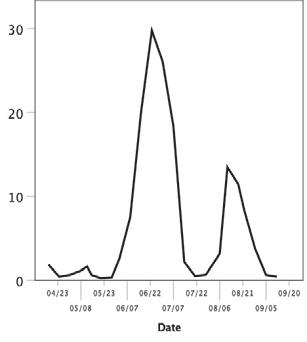
to notice. The worms remain hidden during the day, and unless you spend an hour searching, they are difficult to find. Once larvae reach the fifth instar, they become voracious eaters and can mow down rice quickly. Large larvae feed for about 10 days, plenty of time to defoliate the rice severely when populations are high. After the sixth instar, larvae pu pate lodged between rice tillers. Moths emerge from the pupae, mate and repeat the cycle. By the time the second flush of worms appear in the field, plants are large and defoliation does not impact them negatively; however, the worms can feed on the developing panicles, typically on small panicle branches. In general, panicle injury tends to be less problematic than early defoliation, but there have been fields where panicle injury has resulted in reduced yields.
Unfortunately, the number of moths captured in pheromone traps does not predict the number of worms that will be seen in the field later. In some fields, large number of moths are captured, but then very small worm populations devel
op. This may be because there are many natural enemies in rice fields that may feed on armyworm eggs or small larvae, such as spiders and predatory insects. The traps do predict the timing when the number of worms will peak in the field. One to two weeks after the number of moths peak, the number of large worms will peak. This can be helpful to decide when to start monitoring for defoliation and worm populations more intensively.
Management with Insecticides
As mentioned earlier, the monitoring thresholds for armyworms in rice were developed in the late 1970s. These thresholds indicate that once defoliation reaches 25% of the foliage and worms are still present, a treatment is need ed. Recently, a two-year experiment in which rice foliage was cut to various levels showed that when rice is defoliat ed 50%, yield decreased 4% to 13%. At 25% defoliation, yields were not affected. Considering that armyworm defoliation can progress quickly, setting the thresh old for insecticide application at 25% is appropriate.
The 2015 outbreak showed that pyre throids, the most used insecticides on rice, are not very good at controlling armyworms. Growers and PCAs tried other products registered on rice to reduce populations (carbamates and organophosphates) without success. One registered insect growth regulator insecticide, diflubenzuron, provided good control; however, its preharvest interval is 80 days, and therefore its use must be considered carefully. Over the years, I observed some growers apply pyrethroids preventively by tank mixing them with the clean-up herbi cide application typically done in June. This application pattern did not provide control. Also, given that infestations are difficult to predict early, in some cases these applications may have been unnecessary.
In the past few years, I have conducted several insecticide trials with registered and experimental products. When compiling the results of several of these trials, it is clear that pyrethroids are ineffective, providing at most 50%
22 Progressive Crop Consultant November / December 2022
06/07 07/07 08/06 09/05 05/23 06/22 07/22 Date
Pyrethroid Diflubenzuron Methoxyfenozide
Bt 06/07 07/07 08/06 09/05 05/08 04/23 05/23 06/22 07/22 08/21 09/20 30 20 10 0 Date
Bt
0 Treatment Control (%) 20 40 60 80 100
Chlorantraniliprole
0 Treatment Control (%) 20 40 60 80 100 Pyrethroid Diflubenzuron Methoxyfenozide Chlorantraniliprole
ContinuedfromPage21
to 60% control (Figure 4, see page 22). Diflubenzuron did provide good control; however, its activity seemed to be somewhat slower than methoxyfe nozide. Methoxyfenozide has received annual Section 18 registrations since 2015 and it is on its way to receive a full registration. The trials showed that this insecticide is a great tool for armyworm control. Because it is very effective, it gives managers an opportunity to wait until the action threshold is met and ne glects the need for ineffective preventive applications. Another product we tested for several years was chlorantranilipro le. While this product is not registered for use on rice, our trials show it is very effective and could provide a good ro tational alternative to methoxyfenozide and diflubenzuron to avoid resistance development.
In the trials, we also tested Bacillus thuringiensis (Bt) insecticides. Bt insecticides are effective against many lepidopteran pests in many crops and can be used in organic systems. Un fortunately, the trials showed that Bt insecticides do not give good control of armyworms in rice. I suspect the reason is related to the size of the worms we target for application. Bt insecticides work well against small larvae but are not effective when applied to large worms. Because our monitoring is based on defoliation and targets the fifth and sixth instar larvae, Bt insecti cides do not work well on rice.

Insecticide trials show that there are insecticidal options for armyworm control that can be successful. The threshold of 25% defoliation is still valid and can be used to avoid yield losses. While moth captures are not predictive of worm population density, they can help managers determine when more time should be invested in monitoring fields. This reminds me of what my major professor used to tell growers at meetings: “The best thing you can put in your fields is your shadow.”
Comments about this article? We want to hear from you. Feel free to email us at article@jcsmarketinginc.com
Beautiful high brix Berries
Fresh fruit and vegetables have more flavor when the nutrient pathways mobilize the full range of nutrients into the fruit.
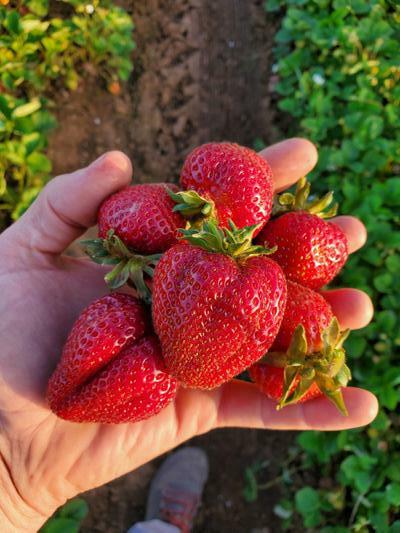
And plants are more resilient to disease and pest pressure when the soil is biologically and nutritionally balanced.
Pacific Gro helps growers improve both soil health and crop quality.


Plant available calcium, amino acid nitrogen and various carbon compounds help mobilize nutrients through the plant. Fish oil feeds beneficial fungi which improve soil structure and crop resilience.

Pacific Gro is produced from salmon and enzymatically digested crab shell. Screened to 150 mesh (100 microns) for use in foliar, drip and pivot irrigation.
Contact us for ways to add Pacific Gro results to your program.
California distributor Deac Jones 415 307 6690 www.andaman ag.com
November / December 2022 www.progressivecrop.com 23
'Unfortunately, the number of moths captured in pheromone traps does not predict the number of worms that will be seen in the field later.'
HOW SPECIALTY CROP FARMERS CAN BENEFIT FROM DRONES AND REMOTE SENSING
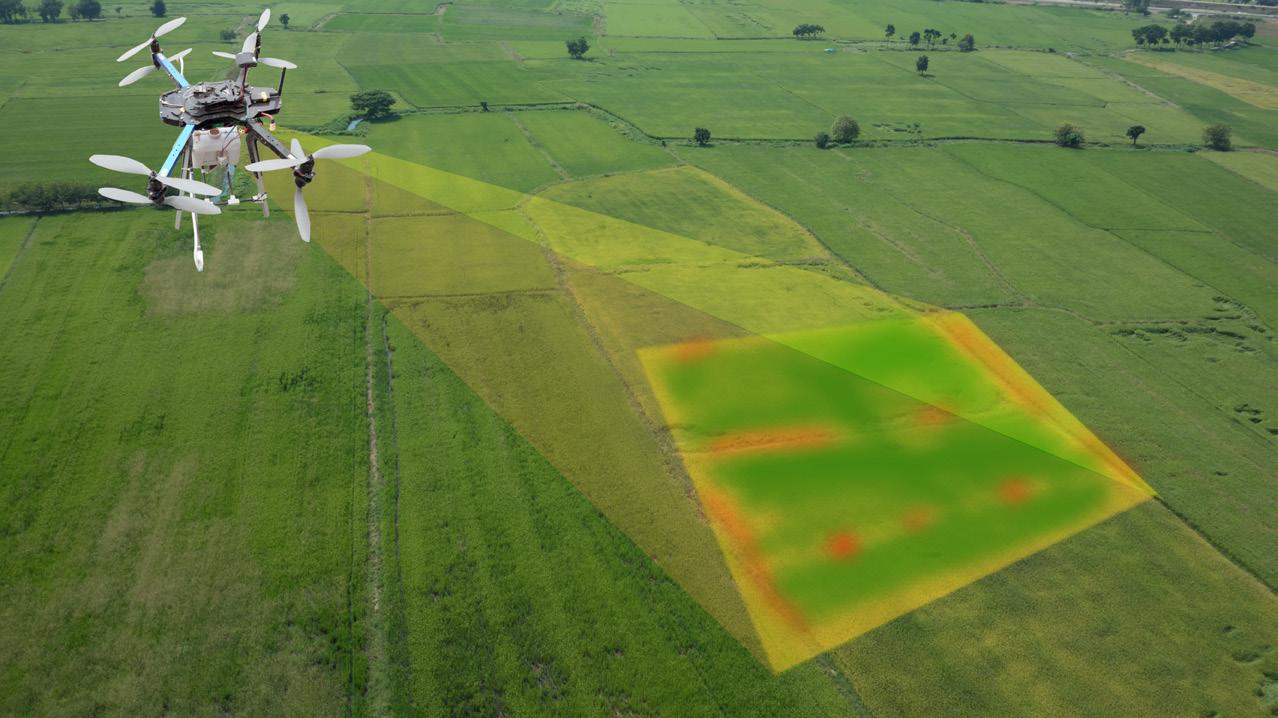 By ALIREZA POURREZ | UC Davis Director, Digital Agriculture Lab; Founder, Kobin Analytics
By ALIREZA POURREZ | UC Davis Director, Digital Agriculture Lab; Founder, Kobin Analytics
There has been a considerable increase in remote sensing tech niques (RS) over the last decade. Re mote sensing can provide farmers with information on crop health, soil condi tions and climate, and opportunities to make better management decisions. The accessibility of uncrewed aerial systems (UAS) provides several potential benefits of using RS techniques for specialty crop production. One recent advantage is that growers can use affordable drones equipped with imaging sensors to mon itor key plant attributes such as plant height, volume, photosynthesis potential, temperature, chlorophyll, nitrogen and diseases throughout the field. Howev er, there are still uncertainties about the best way to use this technology for specialty crop production. The primary focus of this article is on remote sensing in specialty crops: How does it work? Why should growers be interested? What are the applications of RS in specialty crops? And what drawbacks or limita tions should growers consider before adopting RS technology?
This article will also provide basic
information on spectral analysis and discusses the output uncertainty of some common aerial image interpreta tion processes and how to recognize and avoid misleading outputs that would otherwise lead to risky decision-making.
How Does It Work?
Remote sensing (RS) includes infor mation acquired from electromagnetic energy that is reflected or emitted by the
earth to provide spatial and time-inte grated information. It involves collect ing information from sensors deployed on satellites, aircraft, drones or on the ground and the analytics of this data to convert them to insightful knowledge that can be integrated into the farm management decision-making process.
The interaction of sunlight with vegeta tion (how light is absorbed or scattered)
24 Progressive Crop Consultant November / December 2022
Remote sensing (RS) involves collecting information from sensors deployed on satellites, aircraft, drones or on the ground and the analytics of this data to convert them to insightful knowledge that can be integrated into the farm management decision-making process.
One of the potential benefits of
RS is that growers can monitor disease-stricken areas of crops and assist in deciding when to spray fungicides or nutrient sprays based on plant photosynthetic status and vigor indicators.’
"
varies based on how they function in the environment. The fundamental proper ties of leaf spectra were defined a few de cades ago. Leaves’ light absorption and scattering behavior can be affected by crop type, water content, leaf pigments, nitrogen, chlorophyll, disease, stress and age. Multispectral cameras mounted on fixed wings or rotary drones are the most common means of UAS-based remote sensing available to growers. Multispectral cameras are similar to RGB cameras but usually have more than three channels covering visible and near-infrared (400 to 1000 nm) regions.
Two non-visible spectral bands com monly used for multispectral sensors are red edge (within 670 to 760 nm) and near-infrared (NIR, 800 to 900 nm). Imagery from multispectral cameras is usually used to generate vegetation indi ces (VI), such as normalized difference vegetation index (NDVI=(NIR-Red)/ (NIR+Red)) and Normalized Difference Red Edge (NDRE=(NIR-RedEdge)/ (NIR+RedEdge)) that combines two or more bands to generate a single index to indicate plant status. However, vari ous plant health and vigor parameters often influence the index value, making it difficult to draw an inevitable conclu sion. Also, the calibration process for one particular camera cannot be trans ferred to another because of various instrumental characteristics. Therefore, spectral models based on VIs are often not generalizable and highly influenced by the specific dataset used for model calibration. Also, VI-based RS models are purely empirical that ignore the mechanism of light interactions with vegetation.
Alternatively, physical-based models use radiative transfer theory to predict plant traits mechanistically based on the amount of light energy absorbed by the plant and its photosynthetic perfor mance. These models were developed mainly through monochromatic light absorption and reflectance measure ments, which are difficult to capture by multispectral cameras individually. Mechanistic models still face many difficulties regarding the simulated physical processes and their accuracy in predicting plant health. Still, they of
fer a robust interpretation that minimiz es the uncertainty compared to the pure empirical data-driven approaches.
Why Should Growers Be Interested?

Transition to regenerative and sus tainable crop production requires the adoption of precision agriculture (PA) practices, which requires accurate, timely and precise information about plant health, productivity and stress statuses. Farmers can supplement their existing data collection systems with RS methods to conduct frequent and largescale crop monitoring, obtain helpful insight into their field variability, and determine strategies to manage the less productive or stressed zones differently so that they can recover and the entire field can produce more uniformly.
Remote sensing can provide farmers with objective, timely and precise infor mation to manage crops more efficiently and optimize soil health management practices. One of the potential bene
fits of RS is that growers can monitor disease-stricken areas of crops and assist in deciding when to spray fungi cides or nutrient sprays based on plant photosynthetic status and vigor indica tors. Also, growers can gain insight into nitrogen content variability throughout the field through RS-based monitoring systems that will help them to avoid crop loss or soil contamination due to under- or over-fertilization
Applications in Specialty Crops
The most frequent uses of remote sensing in specialty crops are classified into seven groups: water status moni toring, disease detection and control, yield mapping and prediction, nutrient management, phenotyping (breeding), soil and salinity monitoring, and other managerial practices.
Plants under water stress usually show higher temperatures compared to
November / December 2022 www.progressivecrop.com 25
ContinuedonPage26
well-watered plants. Thermal sensing is a traditional method to monitor crop water stress, determine evapotranspiration (ET) and identify a leak or clog in the irrigation system.
Plant disease or any factor that prevents plants from reaching their maximum productivity can show signals that are detect able by spectral cameras. For example, diseases that affect the photosynthesis rate and decrease detectable green biomass will reduce the reflectance in the Red-Edge/infrared region that can be identified with multispectral cameras.
Yield can be forecasted by using RGB imagery to monitor flowers during the bloom time or by analyzing the plant canopy in a 3D environment to determine canopy light inter ception and maximum photosynthesis capacity. Low-altitude UAS-based RGB imagery was also used to identify and count fruits and generate a yield variability map.

Retrieval of plant nitrogen content by RS has been one of the main focuses of researchers in past decades due to the impor tance of precise nitrogen management for avoiding crop loss and environmental contamination. Monitoring crop N con tent is essential at the early vegetative stages to ensure growers can make a timely decision on the best nitrogen management practice that satisfies the nutrition need of all plants. Most leaf
nitrogen is stored in protein detectable in the shortwave infra red (SWIR) region of the electromagnetic spectrum (around 2000 nm). However, commercial multispectral cameras do not cover SWIR, so the nitrogen retrieval models are essen tially based on sensing chlorophyll or other light-harvesting components.
Excessive salt concentration in the soil can reduce osmotic potential and water uptake by increasing the cost of energy re quired for water extraction, transpiration and photosynthetic rate, eventually leading to underproduction. Both thermal and multispectral imaging can be used to monitor the indica tion of salinity indirectly.

Challenges and Limitations

Although the tools and equipment for aerial imaging are more accessible and affordable to growers, it is still challenging to interpret the spectral variability at the canopy level due to the additional impact of the canopy structure on the reflectance measured by cameras. Achieving an excellent spectral repre sentation of the canopy at the canopy level with minimized errors is a challenge facing current RS research.

We must incorporate improved technologies and methods for data collection, analysis, processing, transmission, commu nication and storage to increase remote sensing capabilities for specialty crop production. Interpreting the enormous amount of RS data available using off-the-shelf software requires robust computing and data transfer infrastructure. Also, a standard radiometric calibration and image processing pipeline should be developed to ensure the quality of the in terpreted knowledge extracted from raw data. Finally, we still need to establish the best practices for variable management strategies in specialty crops to increase farmers’ adoption of decision-support tools based on RS technology.

26 Progressive Crop Consultant November / December 2022
ContinuedfromPage25 Comments about this article? We want to hear from you. Feel free to email us at article@jcsmarketinginc.com Order from your PCA or local Ag Retailer / Crop Protection Supplier *One application of Anti-Stress 550® will remain e ective 30 to 45 days, dependent on the rate of plant growth, application rate of product and weather conditions. 559.495.0234 • 800.678.7377 polymerag.com • customerservice@polymerag.com Additional Environmental Stress Conditions that the product is useful for: Frost & Freeze • High Temperatures & Extreme Heat • Drought Conditions • Transplanting • Drying Winds Anti-Stress 550® Beat the Heat & Care for Your Crops with: Optimal application period is one to two weeks prior to the threat of high heat. A foliar spray that creates a semi-permeable membrane over the plant surface. The coating of Anti-Stress becomes e ective when the product has dried on the plant. The drying time of Anti-Stress is the same as water in the same weather conditions. What is Anti-Stress 550®? When to apply Anti-Stress 550®? When is Anti-Stress 550® most e ective?
Farmers can supplement their existing data collection systems with RS methods to conduct frequent and large-scale crop monitoring, and obtain helpful insight into their field variability (photo by Reza Ehsani, UC Merced.)







November / December 2022 www.progressivecrop.com 27 MOCKSI PLANT GROWTH REGULATOR Kim-C1, LLC © 2022 Kim-C1, LLC. All rights reserved. MOCKSI and Kim-C1, LLC logo are registered trademarks of Kim-C1, LLC. Always read and Contact Ben Letizia at 559-284-1392 or benl@kimc1.com for more information MOCKSI® PLANT GROWTH REGULATOR Begin planning for 2023’s almond bloom NOW, understand the benefits of a MOCKSI application and be ready for a strong 2023! Kim-C1, LLC © 2022 Kim-C1, LLC. All rights reserved. MOCKSI and Kim-C1, LLC Contact Ben Letizia at 559-284-1392 or benl@kimc1.com for more information MOCKSI® PLANT GROWTH REGULATOR Begin planning for 2023’s almond bloom NOW, understand the benefits of a MOCKSI application and be ready for a strong 2023! Kim-C1, LLC Contact Ben Letizia at 559-284-1392 or benl@kimc1.com for more information PLANT GROWTH REGULATOR Begin planning for 2023’s almond bloom NOW, understand the benefits of a MOCKSI application and be ready for a strong 2023! Kim-C1, LLC © 2022 Kim-C1, LLC. All rights reserved. MOCKSI and Kim-C1, LLC logo are registered trademarks of Kim-C1, LLC. Always read and follow label directions. 559-228-3311 Contact Ben Letizia at 559-284-1392 or benl@kimc1.com for more information
2022 CCA of the Year Winner
Paul Crout Takes Prestigious Award at This Year’s Crop Consultant Conference CCA
of the year
By TAYLOR CHALSTROM | Editor
The 2022 Crop Consultant Confer ence, hosted on September 28 and 29 in a collaborative effort by JCS Marketing Inc. and Western Region Certified Crop Advisers (WRCCA), saw record attendance and provided a welcomed opportunity for crop consul tants, industry suppliers, researchers and others to network and learn.
In addition to consultants, growers and PCAs receiving much-needed con tinuing education credits during the Conference’s new dual education track, WRCCA also presented its third-annu al Crop Consultant of the Year award and Allan Romander Scholarship and Mentor Awards.
Karl Wyant, director of agronomy at Nutrien and WRCCA Board Chair, pre sented the awards.
CCA of the Year
The CCA of the Year award recognizes a CCA in the western region (North Valley, South Valley, Coast and Desert) of the U.S. who has shown dedicated and exceptional performance as an advisor. The ideal candidate leads others to promote agricultural practices that benefit the farmers and environment in the western region. Selection criteria includes a peer nomination process, a scope of the CCA work, special skills and abilities, professional involvement and mentorship and community in volvement.
This year’s CCA of the Year winner was Paul Crout, senior product manager and agronomist at Helena Agri-Enterprises. Crout is from Templeton, Calif. and attended Cal Poly, San Luis Obispo for his higher education. He’s been a CCA
This year’s CCA of the Year winner was Paul Crout, senior product manager and agronomist at Helena Agri-Enterprises. The ideal candidate leads others to promote ag ricultural practices that benefit the farmers and environment in the western region.

28 Progressive Crop Consultant November / December 2022
for over 12 years, was California Association of Pest Control Advisers’ Member of the Year in 2015 and is a California Ag Leadership Program graduate.




In his award acceptance speech at the Conference, Crout said being a CCA has served him well throughout his career. “That ‘agronomy-first’ mindset, I think, is really the foundation that sets the Certified Crop Advisers apart from other people and other pieces in the industry,” he said. “It’s meant quite a lot to me.”
As a CCA, Crout said he’s always thinking about the future as it relates to agriculture. With many input prices rising, there
Farms across the country are experiencing high fertilizer prices. Plants consume large amounts of N, P, and K for growth and crop production. Price ranges for some common inputs for N are between $800 - $1,500. P inputs are $1,100 - $1,500 and Potassium, K are right around $950 per ton.
Reduced fertilizer e ciency can be expected when the soil acidity is not adequately man aged. The routine addition of quality aglime products will help maintain a near neutral soil pH and increase the e ectiveness of fertilizers while reducing the amount of money wasted.
Check with your certi ed crop advisor for more information on fertilizer e ciency.

Soil pH N P K $ Wasted 5.5 77% 48% 77% $940 6.0 89% 52% 100% $570 6.5 95% 63% 100% $399
Prices dtnpf.com, Chart IPNI
Ask for it by name Blue Mountain Minerals Naturally the Best!
For more information 209-533-0127x112
November / December 2022 www.progressivecrop.com 29
Advertorial
ContinuedonPage30
From left, Dr. Ranjit Singh Riar, Dr. Elizabeth Mosqueda, Jonathan Ebrahimpour and Dr. Samuel Discua were this year’s mentor award recipients. They were each nominated in the South Valley, North Valley, Coastal and Desert regions, respectively.
' '
The ideal candidate leads others to promote agricultural practices that benefit the farmers and environment in the western region.
isn’t much of a choice besides thinking ahead with changing times, innovating and adapting.
“With fertilizer prices, inflation, supply issues, all these challenges that we face as an industry, I look at that as an op portunity,” Crout said, “an opportunity for crop advisers and agronomists to provide more value to their customers.


“They’re really, at the end of the day, the most important piece of our business,” he continued while addressing the 500plus consultant audience. “If they can’t stay in business farming, then you really are going to be out of a job.”
Crout also stressed the importance of CCAs always maintaining the 4R “man tra” of nutrient and water applications: right rate, right source, right time and right place. Additionally, he said, it is the job of CCAs to support all growers, whether they’re conventional, organic, regenerative, etc.
“We’re all trying to do the same thing, and I think [CCAs] are a key component in that.”
Mentor Awards
WRCCA awarded additional scholar ship and mentor awards compared to the previous two years.
Dr. Ranjit Singh Riar, professor in the Jordan College of Agricultural Sciences and Technology at Fresno State Univer sity; Dr. Elizabeth Mosqueda, agricul


ture instructor at Madera Community College and USDA E. Kika De La Garza Fellow; Jonathan Ebrahimpour, agri culture and horticulture adjunct faculty member at Los Angeles Pierce College; and Dr. Samuel Discua, agriculture and plant science lecturer at University of Arizona, were this year’s mentor award recipients. They were each nominated in the South Valley, North Valley, Coastal and Desert regions, respectively.
Dr. Riar plans to use the award funds
30 Progressive Crop Consultant November / December 2022
ContinuedfromPage29
Omar Abulghanam of Fresno, Calif.; Kimberly Holguin of Visalia, Calif.; Made Roger of Cayucos, Calif.; and Donald Benedict of Imperial, Calif. were this year’s scholarship award recipients. All had excellent track records of awards, leadership and community service as well as internship experience.
”
“
With fertilizer prices, inflation, supply issues, all these challenges that we face as an industry, I look at that as an opportunity; an opportunity for crop advisers and agronomists to provide more value to their customers.
– Paul Crout, CCA of the Year winner
to procure materials and supplies for the Plant Science Club plot on the Fresno State campus. Dr. Mosqueda plans to purchase a hand-held pesti cide sprayer unit to show students how sprayers work, how to calibrate spray rates, diagnose performance issues and learn about the impact of spray drift on different crops. Ebrahimpour plans to direct the funding toward the research, development and laboratory equipment needed to create an Advanced Soil Sci ence course. Dr. Discua plans to finance field trips around California’s Imperial Valley and Yuma, Ariz. for a crop pro duction class.
Scholarship Awards
Omar Abulghanam of Fresno, Calif.; Kimberly Holguin of Visalia, Calif.; Made Roger of Cayucos, Calif.; and Donald Benedict of Imperial, Calif. were this year’s scholarship award recipi ents. All had excellent track records

of awards, leadership and community service as well as internship experience. They were each nominated in the South Valley, North Valley, Coastal and Desert regions, respectively.
Abulghanam plans to continue his master’s degree at Fresno State through spring 2023 and earn his CCA creden tial in the next year. Holguin plans to continue working as an agronomist during her bachelor’s degree work and graduate school to pursue a master’s degree in Plant and Soil Science as well as take her CCA exams near grad uation. Roger plans to embrace Cal Poly’s “Learn by Doing” motto by using schoolwork, extracurriculars and work to explore sustainable crop production. She has already earned her QAL and will be ready to earn PCA and CCA licenses next spring. Benedict plans to obtain his CCA license during senior year of college, obtain his PCA license
afterward and begin a career with Hele na Agri-Enterprises.
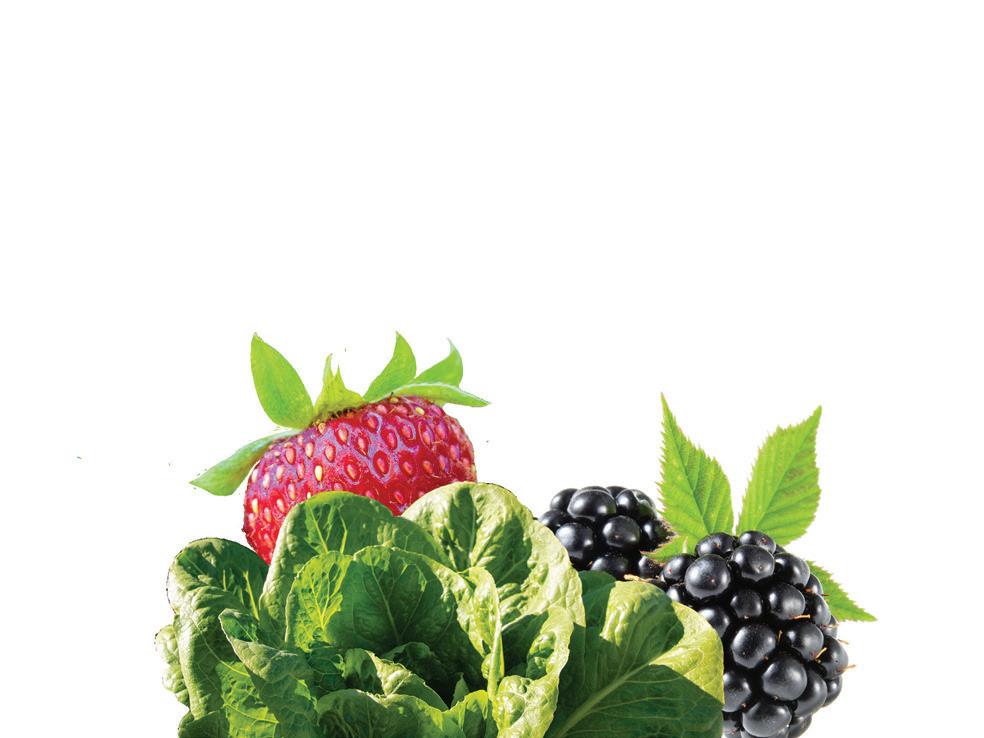
The recipients of this year’s scholarship and mentor awards play a vital role in the development of CCAs in the western region and will continue to educate growers and prospective CCAs in the future.
On behalf of the JCS Marketing Inc. team and Progressive Crops Consultant mag azine, the editor would like to thank all that attended this year’s Crop Consultant Conference in Visalia. The conference was a huge success with record-breaking attendance of over 500 consultants that enjoyed the valuable seminars, exhibitors and great food.
Comments about this article? We want to hear from you. Feel free to email us at article@jcsmarketinginc.com
November / December 2022 www.progressivecrop.com 31
RANGO is a trademark of Terramera. Always read and follow the label.
Boost your pest control with NEW Senstar® Insecticide from Valent U.S.A. With two effective modes of action, Senstar provides stellar control against soft-bodied insects, protecting citrus groves from California red scale and vegetables from aphids and whiteflies. Quickly eliminate harmful insects at all life stages — including eggs — with the next-level power of Senstar.
Contact your PCA or visit Valent.com/Senstar to learn more.

Products That Work, From People Who Care® | valent.com | 800-6-VALENT (682-5368) Always read and follow label instructions.
Products That Work, From People Who Care and Senstar are registered trademarks of Valent U.S.A. LLC. ©2022 Valent U.S.A. LLC. All rights reserved.
NEW FAST-ACTING INSECTICIDE FOR VEGETABLES AND CITRUS NOW APPROVED FOR USE IN CALIFORNIA BOOST YOUR PEST CONTROL Learn More Scan Code to




























 By LUKE
By LUKE










 By JEROME PIER | Ph.D., CCA,
By JEROME PIER | Ph.D., CCA,






















 By KIRK VAN LEUVEN | PCA, CCA, Territory Sales Manager, Stoller USA
By KIRK VAN LEUVEN | PCA, CCA, Territory Sales Manager, Stoller USA

























































 By LUIS ESPINO | UCCE Rice Farming Systems Advisor, Butte and Glenn Counties
By LUIS ESPINO | UCCE Rice Farming Systems Advisor, Butte and Glenn Counties











 By ALIREZA POURREZ | UC Davis Director, Digital Agriculture Lab; Founder, Kobin Analytics
By ALIREZA POURREZ | UC Davis Director, Digital Agriculture Lab; Founder, Kobin Analytics























